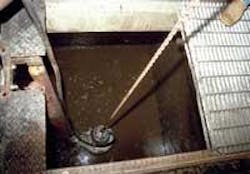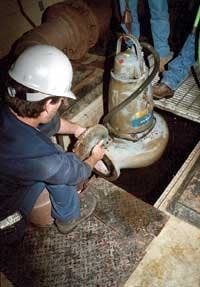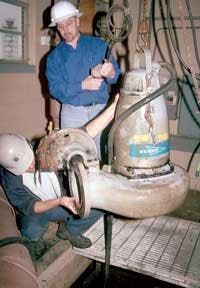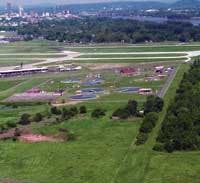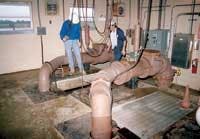New Generation Pump Stops Stoppage at Wastewater Facility
Little Rock (AR) Wastewater Utility used a new-style pump to resolve a recurring clogging problem at its Adams Field Wastewater Treatment Plant (WWTP) that often cripples return activated sludge pumps at plants that added secondary treatment after passage of the Federal Water Pollution Control Act (U.S. Clean Water Act) of 1972.
The Little Rock facility originated in 1961 designed only for primary treatment and now handles 70 percent of the sewage generated within the utility’s service area. The plant was rated at 36 MGD after the addition of secondary treatment in 1972. The plant uses the complete mix activated sludge process that distributes influent sewage, return activated sludge and air throughout the aeration tank to maintain a nearly homogenous mix. A uniform organic load from one end of the tank to the other removes approximately 90 percent of the pollutants.
Like many plants modified for activated sludge treatment, the existing infrastructure at the Little Rock facility -- specifically the coarse screens -- enabled rags and other debris to reach and foul the two 35 hp and two 15 hp return activated sludge submersible pumps. Accordingly, the utility’s management agreed to participate in one of 10 field tests being conducted by ITT Flygt for an experimental submersible pump equipped with an impeller engineered for clog-free operation.
“Our old pumps were installed in the 1980s so it seemed like a win/win situation if we could overcome the fouling and clogging problem,” said Lynn Hyke, Treatment Plant Superintendent. “Our practice had been to routinely back-flush the pumps every four to eight hours to remove debris that had passed through the headworks screens during high velocity flows. We had modified the old pumps with variable frequency drives that under normal conditions enabled us to return-pump 70 percent of the return sludge from the clarifiers to the aeration tanks. During a rain event, however, the relationship of returned sludge to inflow would decrease. If we experienced a blockage, that would easily reduce the return flow capacity by 25 to 50 percent.”
The problem became even more pronounced over long time periods.
“About every two weeks, a big wad of rags or other debris would totally clog the impellers,” he added. “When that happened, if we couldn’t clear them by back-flushing the pumps our people would need to pull the pumps out of the wetwell to de-rag the pumps by hand.”
Measured by man-hours and overhead, clearing the pumps would normally cost the utility $75 to $100 depending on the worker dispatched to the wetwell to back-flush the pump. To physically pull a pump, it took two men more than an hour.
“That was a terribly nasty job”, he said.
Hyke was therefore receptive when Jack Tyler Engineering Company, of Arkansas, the local ITT Flygt factory representative, offered the utility a chance to field test a new generation of RAS submersible pumps equipped with the Flygt “N” impeller. The technologically advanced impeller is engineered to prevent clogging and improve operational efficiency. One of the two smaller-horsepower pumps was replaced with an ITT Flygt prototype rated at 18 hp.
The factory representative was so confident about the N impeller technology on the test pump that the supplier asked the utility to run the test pump until it failed before pulling it from service, Hyke said.
The hydraulic end of the ITT Flygt prototype featured a patented, self-cleaning impeller, a feature that was unavailable during the 1980s when former pumps were installed at the plant.
With the agreement reached, the prototype pump was installed with the intent to run it only four months. Meanwhile, Hyke’s Navy Reserve construction unit was activated on 48-hour notice and sent to Guam to repair typhoon damage to a military installation. While working there he was involved in an accident resulting in serious injuries that delayed his return to Little Rock.
When he finally returned to work, he found the pump on loan was still in place.
“We finally pulled the experimental pump after 18 months to conduct the first inspection. It was still working fine and had never clogged or had a motor failure,” he said. “During that time, however, the other three pumps continued to experience clogging on a daily basis.”
The prototype was then sent back to Flygt for engineering study and the plant received four new pumps, two 25 hp Model N 3201 pumps, and two 12 hp Model N 3152 submersibles, all equipped with the N impellers and OEM VFDs. Hyke said the replacements have fully met performance expectations. The pumps are cooled by a sealed, closed loop system, using a glycol solution. The cooling jacket allows for excellent heat transfer, and its design is most suitable for use with a VFD because the heat transfer is constant throughout the full speed range.
“I have an elevation point set in the return pump station wetwell and maintain a constant flow from the clarifier suction tubes, and there is never any clogging of the pumps.” Hyke said. “The new pumps with OEM variable frequency drives gave me the capability to set my flow based on 60 Hz down to 30 Hz. The new N impellers have all but eliminated the clogging problem, simply by pumping away any debris that passes through the system and reaches the pump intakes.”
Located between two runways of the Little Rock Airport, the Adams Field WWTP receives wastewater from 63,000 homes and businesses via three, 60-inch diameter sewer lines at an average depth of 30 feet below grade. The utility also operates the Fourche Creek Treatment Plant powered by methane off the anaerobic digesters that processes the remaining 30 percent of the city’s sewage.
The utility has invested over $50 million in capital improvements during the first 10 years as part of a capital improvements plan throughout the city. A $20 million upgrade project at the Adams Field plant is scheduled to start in 2005. The scope of work includes replacing the existing coarse screens with new screens having smaller, 3/8" openings. A washer compactor system will clean organic material from the new screens and plant pumping capacity will be increased from the current 72 mgd pumping capacity to 94 mgd. Also planned are a major retrofit of the primary clarifier and mechanical apparatus, along with an improved flow splitter to more evenly load influent into the three primary clarifiers. The primary sludge pumps will be replaced with 400 gpm pumps. A new 14 mgd equalization basin also is planned. WW
